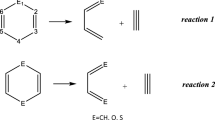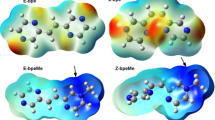Abstract
On the basis of analysis of the electron density redistribution upon excitation, drawing on charge transfer numbers, we have considered the nature of the electronic transitions in the absorption spectra of analogs of 2,5-diphenyloxazole, in which the carbon atom at position 4 of the oxazole ring is bonded to the ortho position of the 5-phenyl fragment of the vinylene, azomethine, amide, and ester groups. We have shown that the differences in the electronic transitions of the basal molecule and the studied structural analogs are determined by the electron-donor effect of the bridging group and the degree of its conjugation with the extended π-electron system of the original molecule. The dialkylamino derivatives of the studied compounds, on the other hand, display a high degree of similarity in the electronic structure of the excited states, and the characteristics of their long-wavelength transitions, such as in the case of substitution of the 2-phenyl fragment, do not depend on the nature of the bridging group of atoms. We give a theoretical explanation of the experimentally observed increase in the intensity of the long-wavelength transitions and the efficiency of luminescence upon introduction of dialkylamino groups into the 2- and 5-phenyl fragments.
Similar content being viewed by others
Literature cited
M. Maeda, Laser Dyes, Academic Press, New York (1984).
A. V. Luzanov, “Structure of electronic excitation in quantum chemical models,” Usp. Khim., 49, No. 11, 2086–2117 (1980).
M. V. Bazilevskii, Molecular Orbital Method and Reactivity of Organic Molecules [in Russian], Khimiya, Moscow (1969).
O. A. Ponomarev, Yu. N. Brusil'tsev, V. Kh. Grif, and V. G. Mitina, “Synthesis and luminescent properties of analogs of 2,5-diphenyloxazole with fixed 5-phenyl radical,” Ukr. Khim. Zh., 56, No. 3, 272–276 (1990).
O. A. Ponomarev, S. I. Kotelevskii, and Yu. F. Pedash, “Analysis of errors and optimization of the experiment in determination of the fluorescent quantum yield,” Zh. Prikl. Spektrosk., 52, No. 5, 763–768 (1990).
V. I. Minkin, B. Ya. Simkin, and R. M. Minyaev, Theory of Molecular Structure. Electron Shells [in Russian], Vysshaya Shkola, Moscow (1979).
Author information
Authors and Affiliations
Additional information
Translated from Teoreticheskaya i Éksperimental'naya Khimiya, Vol. 26, No. 6, pp. 644–650, November–December, 1990.
Rights and permissions
About this article
Cite this article
Ponomarev, O.A., Brusil'tsev, Y.N., Kotelevskii, S.I. et al. Nature of the excited states of dialkylamino derivatives of aromatic and heteroaromatic compounds with an annelated oxazole ring. Theor Exp Chem 26, 605–611 (1991). https://doi.org/10.1007/BF00536423
Received:
Issue Date:
DOI: https://doi.org/10.1007/BF00536423




